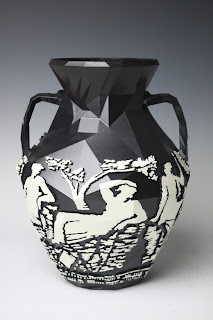MAREK CECULA – artist, designer, educator and all-round dynamo has returned home to Kielce in Poland and created
Design Centrum Kielce.
Marek invited me to speak at the opening of the centre, held in June. Rather than simply talking about my own work, I used the opportunity to discuss the impact of digital technology on craft and design and its place in Design education.
Synopsis:
Digital technology is having a profound effect on the way in which we engage with the world and with the objects that surround us. Many people think that there is a risk that these shiny new tools will lead to a loss of traditional skills. I would like to discuss the place of these new tools in relation to design education and use my practice as an example of one way to bring together the old and the new.
Lecture:
First of all I would like to thank you for inviting me today. It really looks like it’s full steam ahead for DCK and great for me to be here at the beginning of an exciting journey.
The creation of a new Design School at this particular point in time is very much to be welcomed as there needs to be a shift in thinking around the subject of design education.
I am not qualified to discuss the pedagogy of design education as I am a maker and that’s really why I’m here, but I do have some experience both as a student and a teacher.
I’ll talk about being a student a bit later on; as a teacher my experience is mixed.
In the UK, many Design Schools are being seduced by the ‘Media of Attraction’ (Lunenfeld, 2001) where the novelty of digital technology leads to the abandonment of older technologies and the closure of traditional workshops. This inevitably leads to the creation of superficial objects, where there is little understanding of materials, processes or the 3 dimensional form. I have been lucky to teach in 2 establishments where the policy has been to keep the workshops open. It is where students can explore materials and learn through making. Though they are expensive to operate, workshops are recognised as having a value. However, this situation is rare, most universities are run by accountants who would rather fill their workshops full of computers; it's cheaper and you can pack more students in.
But don’t get me wrong; I love new technology and the creative opportunities it offers. Computers are miraculous and have reshaped the way we engage with the world. But they are an addition to the tools that makers can choose to use, not a replacement and that’s really what I would like to talk about today.
Technology such as 3D printing is starting to fundamentally change our relationship to the things we choose to live with.

Here’s a great example. This chair, created by Dirk Vander Kooij is made by extruding plastic through the nozzle of a robotic arm.
The material comes from recycled white goods such as refrigerators and the use of this machine is an example of how the creative industries are appropriating technology and making it do exciting things it wasn’t intended for.
However, you don’t need one of these to access 3D printing. As I'm sure you know, these new tools are no longer confined to hi-tech industries.
Already websites like Shapeways and Sculpteo are offering anyone who can afford it, the opportunity to customize a design or create their own and have them 3D printed and delivered to their door.

As 3D printing becomes cheaper and more commonplace, are we going to see established companies allowing their customers to create personalized versions of their designs?
The technology to do this sort of thing is becoming increasingly accessible.
I can use my phone to design a bespoke vase based on my profile, and have it printed and glazed. Would anyone like to place an order? I didn’t think so.
What effect is this going to have on design? Is this ability, available to large numbers of people going to produce better design? Are we going to see the mass democratization of design? Will it encourage more young people to study design or will they think they know it all just because they have some clever software?
Or will it simply result in the world consuming more and more of its increasingly valuable resources to produce more stuff destined for landfill?
It must be a good thing for more people to understand design and its creative potential. But access to this wonderful new toolbox is unlikely to produce better stuff. Working in the virtual world of the computer doesn't teach you about materials and processes. It should be underpinned by working with the hands, testing materials, exploring processes. In other words learning by doing. Getting involved in making things at an early age and staying involved must surely be the way forward and that is why I would like to congratulate Marek and his team for having the vision to create this ambitious new school.
As I said earlier, I am not rejecting technology, I am not saying that we need a new Arts and Crafts movement, well perhaps we do, but with a more inclusive philosophy to that of William Morris and one that embraces the new technology and recognises the craft of working with code.
I am not saying that I have the answers, but I would like to describe the journey that I have made as one possible way of creatively combining the old and the new...
(I then went on to talk about the relationship between hand and digital processes in the development of my work, but you've probably heard all about that before...)




